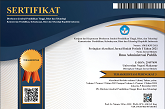The Influence of Leadership and Work Environment on Employee Performance at PT. Suksesindo Pratama in Jakarta
(1) Pamulang University, Indonesia
(*) Corresponding Author
DOI: https://doi.org/10.26858/jiap.v10i1.14468
Abstract
To achieve the goals of the company, then a leader must apply a leadership style to manage his subordinates because a leader will greatly influence the success of the organization in achieving its objectives. This study aims to determine the effect of leadership and work environment on employee performance at PT. Suksesindo Pratama in Jakarta. The method used was explanatory research with a sample of 60 respondents. The analysis technique uses statistical analysis with regression testing, correlation, determination, and hypothesis testing. The results of this study leadership have a significant effect on employee performance by 45.5%, hypothesis testing obtained significance 0,000 <0.05. The work environment has a significant effect on employee performance by 24.4%, the hypothesis test obtained a significance of 0,000 <0.05. Simultaneous leadership and work environment significantly influence employee performance by 50.7%, hypothesis testing obtained significance 0,000 <0.05
Keywords
Full Text:
PDFReferences
Ali, N. M., Jangga, R., Ismail, M., Kamal, S. N.-I. M., & Ali, M. N. (2015). Influence of Leadership Styles in Creating Quality Work Culture. Procedia Economics and Finance, 31, 161–169. https://doi.org/https://doi.org/10.1016/S2212-5671(15)01143-0
Backhaus, R., Rossum, E. van, Verbeek, H., Halfens, R. J. G., Tan, F. E. S., Capezuti, E., & Hamers, J. P. H. (2017). Work environment characteristics associated with quality of care in Dutch nursing homes: A cross-sectional study. International Journal of Nursing Studies, 66, 15–22. https://doi.org/https://doi.org/10.1016/j.ijnurstu.2016.12.001
Buil, I., Martínez, E., & Matute, J. (2019). Transformational leadership and employee performance: The role of identification, engagement and proactive personality. International Journal of Hospitality Management, 77, 64–75. https://doi.org/https://doi.org/10.1016/j.ijhm.2018.06.014
Céspedes-Lorente, J. J., Magán-Díaz, A., & Martínez-Ros, E. (2019). Information technologies and downsizing: Examining their impact on economic performance. Information & Management, 56(4), 526–535. https://doi.org/https://doi.org/10.1016/j.im.2018.09.012
Çetin, M., Karabay, M. E., & Efe, M. N. (2012). The Effects of Leadership Styles and the Communication Competency of Bank Managers on the Employee’s Job Satisfaction: The Case of Turkish Banks. Procedia - Social and Behavioral Sciences, 58, 227–235. https://doi.org/https://doi.org/10.1016/j.sbspro.2012.09.996
Chulvi, V., Agost, M. J., Felip, F., & Gual, J. (2020). Natural elements in the designer’s work environment influence the creativity of their results. Journal of Building Engineering, 28, 101033. https://doi.org/https://doi.org/10.1016/j.jobe.2019.101033
Freitas, V., & Duarte, M. (2017). Motivation at work: Case studies of Portuguese SMEs. Tékhne, 15(2), 88–99. https://doi.org/https://doi.org/10.1016/j.tekhne.2017.11.002
Jansen, E. P. (2011). The effect of leadership style on the information receivers’ reaction to management accounting change. Management Accounting Research, 22(2), 105–124. https://doi.org/https://doi.org/10.1016/j.mar.2010.10.001
Li, C. Z., Zhao, Y., Xiao, B., Yu, B., Tam, V. W. Y., Chen, Z., & Ya, Y. (2020). Research trend of the application of information technologies in construction and demolition waste management. Journal of Cleaner Production, 263, 121458. https://doi.org/https://doi.org/10.1016/j.jclepro.2020.121458
Lin, L., Shadiev, R., Hwang, W.-Y., & Shen, S. (2020). From knowledge and skills to digital works: An application of design thinking in the information technology course. Thinking Skills and Creativity, 36, 100646. https://doi.org/https://doi.org/10.1016/j.tsc.2020.100646
Meneton, P., Hoertel, N., Wiernik, E., Lemogne, C., Ribet, C., Bonenfant, S., Ménard, J., Goldberg, M., & Zins, M. (2018). Work environment mediates a large part of social inequalities in the incidence of several common cardiovascular risk factors: Findings from the Gazel cohort. Social Science & Medicine, 216, 59–66. https://doi.org/https://doi.org/10.1016/j.socscimed.2018.09.042
Niswaty, R., Juniati, F., Darwis, M., Salam, R., & Arhas, S. H. (2019). The Effectiveness of Leadership Functions Implementation in The Makassar Departement of Manpower. JPBM (Jurnal Pendidikan Bisnis Dan Manajemen), 5(1), 1–10.
Park, S. H., Lee, P. J., Lee, B. K., Roskams, M., & Haynes, B. P. (2020). Associations between Job Satisfaction, Job Characteristics, and Acoustic Environment in Open-plan Offices. Applied Acoustics, 168, 107425. https://doi.org/https://doi.org/10.1016/j.apacoust.2020.107425
Rivai, V., & Mulyadi, D. (2012). Kepemimpinan dan Perilaku Organisasi. In Kepemimpinan dan Perilaku Organisasi.
Ross, J. (2017). Organizational Support, Workload, and Intent to Stay: Work Environment Perceptions in Perianesthesia Nursing Units. Journal of PeriAnesthesia Nursing, 32(4), 287–294. https://doi.org/https://doi.org/10.1016/j.jopan.2015.07.001
Salau, O., Worlu, R., Osibanjo, A., Adeniji, A., Oludayo, O., & Falola, H. (2018). Survey data on work environments and productivity of academic staff of selected public universities in Nigeria. Data in Brief, 19, 1912–1917. https://doi.org/https://doi.org/10.1016/j.dib.2018.06.074
Sanyal, M. K., & Biswas, S. B. (2014). Employee Motivation from Performance Appraisal Implications: Test of a Theory in the Software Industry in West Bengal (India). Procedia Economics and Finance, 11, 182–196. https://doi.org/https://doi.org/10.1016/S2212-5671(14)00187-7
Stollberger, J., Las Heras, M., Rofcanin, Y., & Bosch, M. J. (2019). Serving followers and family? A trickle-down model of how servant leadership shapes employee work performance. Journal of Vocational Behavior, 112, 158–171. https://doi.org/https://doi.org/10.1016/j.jvb.2019.02.003
Suganthi, L. (2019). Examining the relationship between corporate social responsibility, performance, employees’ pro-environmental behavior at work with green practices as mediator. Journal of Cleaner Production, 232, 739–750. https://doi.org/https://doi.org/10.1016/j.jclepro.2019.05.295
Supardianto, Ferdiana, R., & Sulistyo, S. (2019). The Role of Information Technology Usage on Startup Financial Management and Taxation. Procedia Computer Science, 161, 1308–1315. https://doi.org/https://doi.org/10.1016/j.procs.2019.11.246
Tomczak, D. L., Lanzo, L. A., & Aguinis, H. (2018). Evidence-based recommendations for employee performance monitoring. Business Horizons, 61(2), 251–259. https://doi.org/https://doi.org/10.1016/j.bushor.2017.11.006
Tsai, C.-Y., Horng, J.-S., Liu, C.-H., & Hu, D.-C. (2015). Work environment and atmosphere: The role of organizational support in the creativity performance of tourism and hospitality organizations. International Journal of Hospitality Management, 46, 26–35. https://doi.org/https://doi.org/10.1016/j.ijhm.2015.01.009
Viete, S., & Erdsiek, D. (2020). Mobile Information Technologies and Firm Performance: The Role of Employee Autonomy. Information Economics and Policy, 51, 100863. https://doi.org/https://doi.org/10.1016/j.infoecopol.2020.100863
Article Metrics
Abstract view : 1600 times | PDF view : 325 timesRefbacks
- There are currently no refbacks.
Copyright (c) 2020 Mukhlis Catio

This work is licensed under a Creative Commons Attribution 4.0 International License.
Diterbitkan oleh:
Program Studi Ilmu Administrasi Publik
Program Pascasarjana Universitas Negeri Makassar
JIAP Index By:

This work is licensed under a Creative Commons Attribution 4.0 International License.









